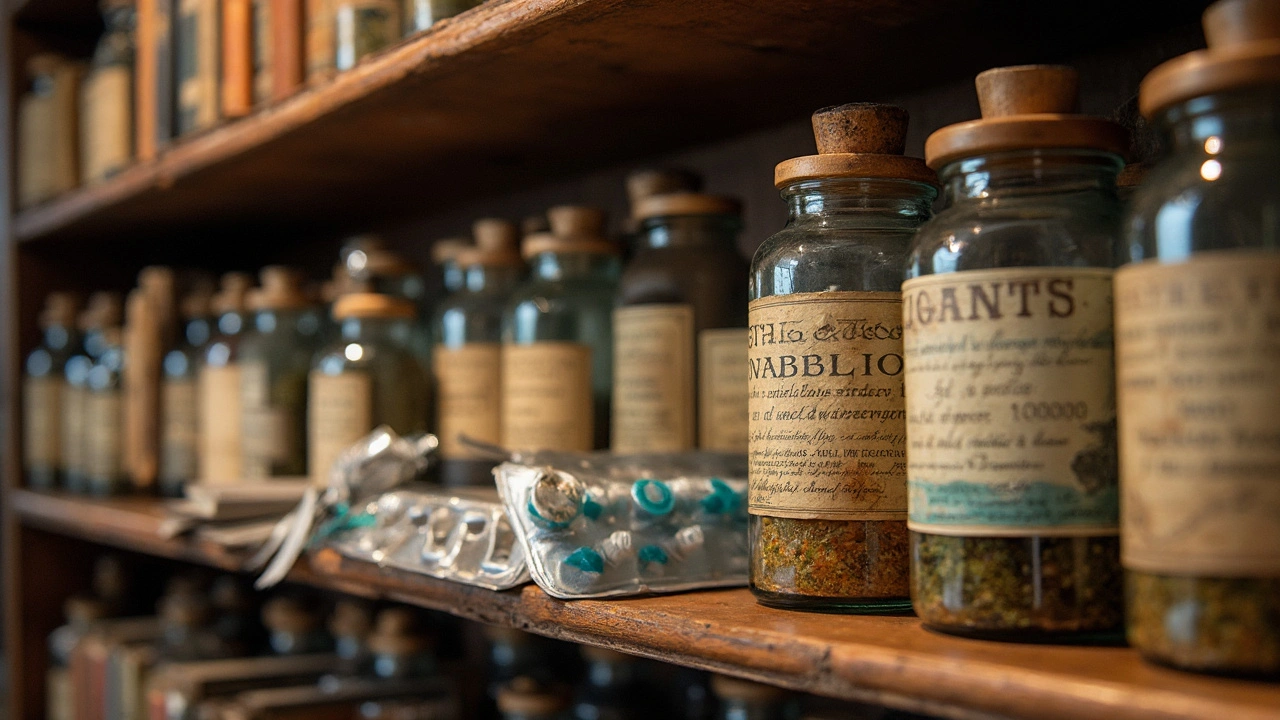There’s a stubborn myth roaming the streets in some corners of the world: that tuberculosis (TB) is some relic of history. Tell that to the 7.5 million people diagnosed with it in 2022, according to the World Health Organization. TB is a thief—a chronic infectious disease that loves to linger in low-light corners, thriving on poverty and crowded living. It doesn’t care about your calendar. And while antibiotics have transformed TB care over the last century, there’s another side to the story: traditional medicine. Is it a help, a hindrance, or something more complicated?
Understanding Tuberculosis: More Than a Lung Disease
Tuberculosis wears many masks. Most folks know it as a coughing, lung-wrecking infection, but the truth is sneakier. TB can lodge itself just about anywhere—the bones, the brain, the kidneys. Symptoms can be so vague—weight loss, night sweats, fatigue—that people ignore them for months, giving TB time to dig in. Mycobacterium tuberculosis, the bacteria at the helm of all this trouble, spreads through the air, usually via droplets released when someone with active TB coughs or sneezes. You don’t need much exposure; the bacteria are tenacious. Once inside the body, they can hibernate for years before flaring up.
Here’s a mind-boggling fact: about a quarter of the world’s population carries latent TB infection. They have the bacteria lurking inside but show no symptoms—so they’re not sick, and they’re not contagious. But that slumber can end any time, usually if your immune system weakens. Certain groups are sitting ducks—people with HIV, folks whose nutrition is shaky, those in overcrowded housing, and, yes, anyone who skips medications. TB doesn’t discriminate, but it follows patterns. It hits hardest in South Asia, Africa, Eastern Europe, and pockets of the Americas, where conditions for spread are ripe.
So, why aren’t we winning the war with all these modern drugs? The ugly truth is that drug-resistant TB is surging. Some strains have become resistant to the antibiotics that once wiped them out, thanks to incomplete treatments, counterfeit meds, or poor access to health services. According to WHO, in 2022, approximately 410,000 people developed multidrug-resistant TB. That’s where desperation sets in for many patients and families—driving them toward traditional healers and remedies they trust, sometimes out of choice, sometimes simply because it’s all they’ve got.
Roots of Traditional Medicine in Tuberculosis Treatment
The dance between humans and TB stretches deep into history, back to when ancient Egyptians and Greeks wrote about “consumption” thinning people to skin and bone. Long before lab coats and pills, people turned to whatever nature offered. Whether it was Chinese herbal concoctions, Indian Ayurvedic combinations, African bush teas, or Andean steam baths, every culture produced their own TB remedies steeped in tradition. Even now, in rural Uganda or the mountains of Nepal, people trek to healers for herbal steam inhalations, holy water, and plant-based tonics that promise to "draw out the sickness.”
Why do these old ways still hold power? Part of it’s about access—modern health facilities can be miles away, too expensive, or simply distrusted. There’s also cultural muscle memory: in some places, the healer is a fixture in community life, seen as more approachable than a medical system that feels cold or judgmental. In India, for example, traditional Ayurvedic clinics often treat patients with TB symptoms who may or may not ever set foot in a government facility. “Chyawanprash” (an herbal jam) and “golden milk” made from turmeric and milk are two traditional remedies patients turn to for boosting strength.
China presents a fascinating case. Traditional Chinese Medicine (TCM) has its own official seat at the table in the national health system. Here, TB patients often receive herbal decoctions in tandem with hospital prescriptions. Astragalus and licorice root, two staple herbs, are believed to “support Qi” (vital energy) and help clear chronic infections. In South Africa, many healers recommend ‘umhlonyane’ (Artemisia afra) as a natural remedy to soothe cough and respiratory symptoms. The science? Sometimes fuzzy, sometimes promising, but always woven into the daily lives of people dealing with TB.
But not all that glitters is gold. Some herbal remedies can actually interact poorly with standard TB drugs, or delay diagnosis if they’re used alone. The line between tradition and evidence-based medicine is tricky, and the stakes are high. Missing the window for early TB treatment means more severe disease—and more spread in the community.

Traditional Medicine: Do the Remedies Actually Work?
Time to pull back the curtain. Does traditional medicine actually do anything for TB, or is it just the comfort of ritual and belief? The honest answer: it depends. Hundreds of studies have tackled this, but clear answers are rare, partly because traditional medicine is a mixed bag—your neighbor’s miracle root tea isn’t my grandma’s stewed herbs. That said, the World Health Organization does not recommend traditional remedies as replacements for proven science-based TB treatments, but it doesn’t dismiss their value outright either, especially when it comes to symptom management and emotional support.
Scientific curiosity has led researchers to check the real properties of plants used by healers. Studies in China found that some TCM herbs like Cordyceps sinensis and Scutellaria baicalensis might have minor antibacterial powers, potentially helping suppress the growth of TB bacteria in lab dishes. Turmeric’s active compound, curcumin, shows promise as an anti-inflammatory, though not a cure. Indian researchers investigating Ayurveda found that Asparagus racemosus and Tinospora cordifolia may support immune function. These findings are interesting, but they aren’t magic bulbs that burn through a TB infection alone.
What’s often overlooked is the mind-body boost traditional medicine can give. Tuberculosis isn’t just a disease of the lungs or bones—it’s a disease of isolation and despair. Ritual, group support, and the attention of a community healer can help patients stick with long and gruelling antibiotic regimens. In places like South Africa, community-based herbal clinics have nudged up patients’ rates of completing the full six months of TB pills—a trend confirmed by several small town studies.
On the flip side, some remedies do more harm than good. Certain herbal ingredients can cause toxic liver reactions, especially when paired with modern antibiotics. There have even been scattered cases of traditional medicine preparations laced with heavy metals or protected animal parts—raising serious ethical, legal, and health concerns. It’s also not uncommon for people to delay visiting a hospital in favor of trying traditional remedies first, wasting precious time. A 2023 Ethiopian study found that nearly 40% of rural TB cases visited traditional healers before a medical clinic, and over half of them waited at least a month extra before getting tested for TB. That’s a lot of missed opportunities for early cure.
On top of that, drug interactions are a real risk. For example, St. John’s Wort—a plant sometimes used for energy or mood—can weaken the effect of rifampicin, a cornerstone TB drug. So, mixing and matching old remedies and new isn’t something to do without guidance. Successful programs in Vietnam and Peru have started to train local healers to recognize TB symptoms and send suspicious cases straight to clinics, bridging traditional respect with modern science.
Balancing Tradition and Modern Medicine for TB Today
So, what’s the path forward? The smartest answers come from the places where medical professionals and traditional healers start talking instead of competing. Take Thailand: government doctors provide antibiotics but also give workshops to village healers, teaching them red flag TB symptoms and ways their herbal knowledge can mesh safely with conventional care. In return, the healers help patients stick with their full course of pills, using rituals and community check-ins to encourage them.
Here are some practical tips if you or a family member is facing TB and considering traditional medicine:
- Never skip or interrupt prescribed antibiotics, even if you’re using herbal or traditional remedies. The only proven cure for TB is the right meds, taken fully and on time.
- Tell your doctor about any teas, supplements, or folk remedies you’re taking. It may feel awkward, but full disclosure helps catch possible dangerous interactions.
- Use traditional therapies for what they do best: easing discomfort, boosting nutrition, and keeping spirits strong—never as a substitute for medical care.
- Look for collaborative clinics or support groups where modern and traditional health workers team up. These are popping up in TB hotspots all over the world.
- If you’re hunting for home remedies, stick with foods and herbs known to be safe: ginger tea, turmeric milk, honey for sore throats. Avoid blends or powders whose ingredients aren’t clearly labeled.
Here’s a quick look at some traditional TB remedies and what the research actually says:
| Remedy / Practice | Region | Purported Benefit | Actual Evidence |
|---|---|---|---|
| Astragalus Root (TCM) | China | Boosts immunity, relieves fatigue | Possible immune support, but not a standalone treatment for TB |
| Chyawanprash (Ayurveda) | India | General tonic, enhances lung health | No direct TB cure, but may help with nutrition and strength |
| Artemisia afra (Umhlonyane) | Southern Africa | Soothes cough, clears the lungs | Useful for managing symptoms, but not proven to treat TB bacteria |
| Turmeric Milk | South Asia | Anti-inflammatory | Helps with inflammation, but insufficient evidence as a TB cure |
| Cordyceps sinensis | East Asia | Fights chronic infections | Minor antibacterial activity in labs, not established in humans for TB |
Just because it’s labeled traditional or natural doesn’t mean it’s harmless—or powerful enough to kill TB. The great strength of today’s TB fight is the ability to blend what works: proven medicines, well-studied nutrition, community support, and yes, the energy and meaning people find in traditional practices. But there’s no shortcut: to beat tuberculosis, the antibiotics must come first, with everything else tailored to support the journey. That’s the real balance—respect the old, trust the new, and always, always finish your pills.


It's absolutely crucial that we stop treating TB like a relic and start treating it like the public health emergency it is. Skipping your meds because a healer promised a quick fix is not just irresponsible, it's downright dangerous. When you combine untested herbs with rifampicin you risk drug resistance, and that endangers everyone.
i get why folks turn to tradition – it feels familiar and sometimes the clinics are miles away. that said, sharing what you're taking with your doc can prevent nasty interactions. just a heads‑up, some of those teas can mess with the antibiotics if you don’t let the doc know.
Let me lay it out straight: tuberculosis is not a fantasy, it is a real killer that continues to strike down thousands of lives across the globe every single day, and the notion that we can simply replace proven antibiotics with a cup of herbal tea is, frankly, an insult to the science that has saved countless families; the history of TB is littered with failed experiments, half‑baked treatments, and the tragic loss of patients who believed in miracles over medicine, and while I respect cultural heritage, we must draw an unambiguous line between reverence and dangerous negligence; the World Health Organization has repeatedly warned that drug‑resistant strains are on the rise, a trend fueled by incomplete courses and unregulated remedies, and if we allow traditional concoctions to replace or delay proper therapy, we are essentially feeding the beast; moreover, the pharmacokinetic interactions between certain botanicals – think St. John’s Wort or high‑dose licorice – and first‑line TB drugs like rifampicin are well documented, leading to sub‑therapeutic levels and potential treatment failure; that is why health ministries in China and India are trying to integrate traditional practitioners into the formal health system, not to endorse their potions as cures, but to use their trusted voices to ensure patients complete their drug regimens; we cannot ignore the psychosocial benefits of community healers – they provide emotional support, reduce stigma, and improve adherence – yet these benefits must be harnessed alongside, not in place of, antibiotics; the bottom line is that the only proven cure for TB lies in the six‑month regimen of first‑line drugs, and anything that detracts from that pathway is a gamble with lives; so, let us celebrate the cultural richness of traditional medicine while keeping our eyes firmly fixed on the evidence‑based protocols that have been rigorously tested and validated.
Traditional herbs can be helpful but they also hide risks the science often ignores they may clash with rifampicin and other TB meds making treatment less effective and that delay can turn a curable case into a deadly one
Hey everyone, just wanted to add that supporting a TB patient doesn't have to mean choosing one approach over the other. You can absolutely encourage them to stay on their antibiotic schedule while also suggesting safe, nutrition‑rich foods like ginger tea or turmeric milk to keep their energy up. If you have a trusted local healer, see if they’re open to learning the red‑flag symptoms so they can point people to a clinic early. Small steps like these create a bridge between tradition and modern care and can really boost treatment adherence.
i think people overhype the herbs they talk about many of them have no real effect on TB and sometimes they cause more harm than good like liver damage especially when mixed with meds you should stick to the proven drugs and maybe only use simple teas for comfort.
While I appreciate the enthusiasm for integrating traditional practices, let's not forget that the primary goal is to eradicate the Mycobacterium tuberculosis bacterium, not just alleviate coughing fits. The data from multiple randomized trials consistently show that without a full course of first‑line antibiotics, the probability of cure plummets dramatically. Moreover, the variability in herbal preparations-different active constituents, dosages, and contamination risks-makes them unreliable as stand‑alone therapies. Even if we consider them as adjuncts, rigorous pharmacological studies are required to map out interactions, especially with rifampicin and isoniazid, which have narrow therapeutic windows. In regions where health infrastructure is weak, the temptation to rely solely on herbal remedies can perpetuate cycles of transmission, fostering drug‑resistant strains that are far more costly to treat. Therefore, any program that seeks to blend tradition with modern medicine must prioritize training healers to recognize TB signs early and refer patients promptly, rather than encouraging them to experiment with unverified concoctions. This balanced approach respects cultural practices while safeguarding public health outcomes.
Sounds like a solid plan – keep the meds, add the tea 😊